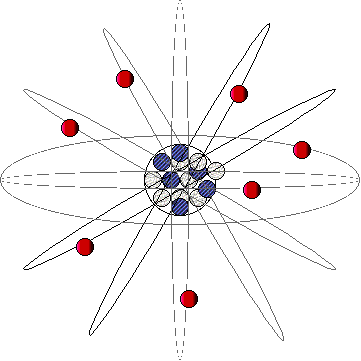



Nuclear Structure
At atom is composed of a nucleus that is incredibly dense -- and has most of the mass. This nucleus has a positive electric charge. Around the nucleus are electrons which have a negative electric charge. You might think of these electrons as tiny planets in orbit around a massive sun, somewhat like our own solar system. A better picture, though, is to think of this is some kind of a smeared-out "electron cloud".
The nucleus of an atom is composed of protons and neutrons. Protons are positively charged and carry one electronic charge + e (e = 1.6 x 10-19 C), the same electric charge as the negative charge carried by an electron (but of opposite sign). The mass of a proton is
mp = 1.6726 x 10-27 kg Neutrons carry no electric charge; they are electrically neutral. The mass of a neutron is slightly greater than that of a proton,
mn = 1.6749 x 10-27 kg Protons and neutrons are similar; together, they are referred to as nucleons. Nucleons are much more massive than electrons; the mass of an electron is
me = 9.11 x 10-31 kg As with the electrons surrounding the nucleus, we must remember that the nucleons inside the nucleus are not tiny balls. Rather, they have the same "wave-particle duality" characteristics as everything else. We may draw pictures of close-packed spheres for convenience but these pictures are only for convenience; they are not a wholly accurate representation.
Hydrogen has the simplest nucleus, composed of a single proton. Other nuclei contain both neutrons and protons. The total number of nucleons is labeled A and is known as the atomic mass number. Since the nucleons are so much more massive than the electrons, this atomic mass number A does, almost entirely, determine the mass of the whole atom. The number of protons is labeled Z and is known as the atomic number. Since this also equals the number of electrons, it determines the element itself and its chemical characteristics. The number of neutrons is labeled N and is known as the neutron number;
N = A - Z Nuclei with the same number of protons (Z) but different numbers of neutrons (N) are called isotopes; they have different masses but are the same element, having the same chemical characteristics. We specify these isotopes by writing them in the form of
where
is the chemical symbol for the element in question, A is the atomic mass number, and Z is the atomic number. Since Z and the chemical symbol supply the same information, it is redundant to list them both. Therefore, an isotope is often specified by writing only the chemical symbol and the atomic mass number in the following form
Both forms contain the same information and both forms are commonly used.
All carbon contains six protons and six electrons so Z = 6 for carbon whose chemical symbol is C. Most ordinary carbon contains six protons and six neutrons for an atomic mass number of A = 12; we write that as 12C. 98.9% of naturally occurring carbon is 12C . 1.1% of naturally occurring carbon has an additional neutron (N = 7) and is, therefore, 13C . Other isotopes of carbon are , , , and 11C, 14C, 15C, 16C. Verbally, we speak of these as carbon-11, carbon-14, carbon-15, and carbon-16.
(c) Doug Davis, 2002; all rights reserved
ToC Nuclear Binding Energy Return to Ch 30, Nuclear Physics